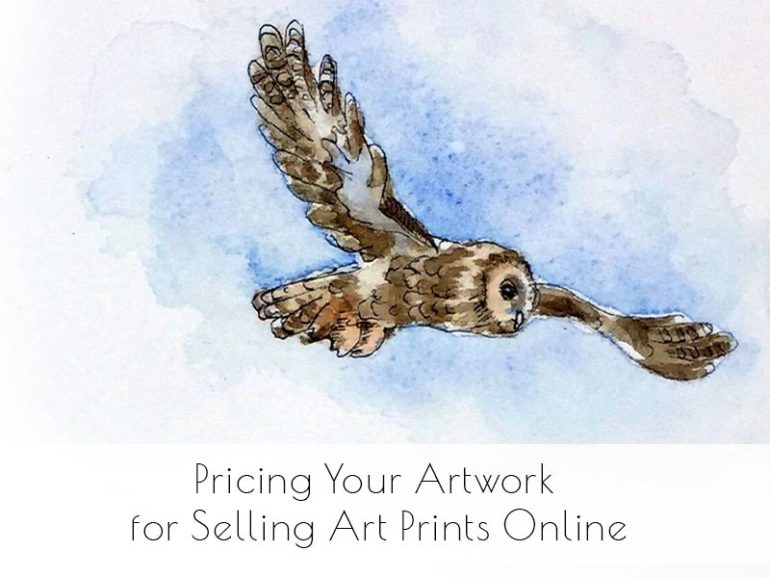Selling art prints online can be an excellent way for our students to generate income from their work. However, pricing your art prints can be challenging. You want to ensure your work is accessible while also valuing your time, effort, and creativity appropriately. This guide will help students navigate the complexities of pricing their art prints for online sales.
Understanding the Market
Before setting a price for your art prints, it’s crucial to understand the market. Research what similar artists are charging for their prints. Look at various platforms like Etsy, Saatchi Art, and local online galleries. Also larger prints and those made with higher-quality materials (e.g., archival paper, giclée printing) generally sell for more.

Understanding Your Costs
Before you can set a price for your art prints, you need to understand the costs involved in creating and selling them. These costs can be broken down into several categories:
- Material Costs: Calculate the expenses related to materials, including:
- Art Supplies: The cost of paint, canvas, brushes, or digital tools.
- Printing Costs: If you’re printing physical copies, consider the price per print for paper, ink, and any other printing materials.
- Packaging Costs: Don’t forget to include the cost of packaging materials to protect your prints during shipping.
- Overhead Costs: These are indirect costs associated with your art business, such as:
- Website Fees: The cost of hosting your online store or portfolio.
- Marketing Expenses: Consider the costs for advertising, social media promotions, or any collaborations.
- Transaction Fees: If you’re using platforms like Etsy, PayPal, or Shopify, they often charge fees for transactions.
- Time and Labour: This is often the most overlooked factor. Calculate how much you value your time:
- Hourly Rate: Decide on an hourly wage that reflects your skills and experience.
- Creation Time: Estimate how long it takes you to create a piece, from concept to finished print.
By compiling all these costs, you can establish a baseline price that ensures you cover your expenses and, ideally, make a profit. Once you have a clear understanding of your costs, you can explore different pricing strategies.

Cost-Plus Pricing
This method involves adding a markup to your total costs to ensure a profit. For example, if your total cost per print is £20, you might add a 50% markup, setting your price at £30. This method ensures all your expenses are covered while providing a clear profit margin.
Market-Based Pricing
Consider what similar art prints are selling for in your niche. If comparable prints are priced at £40, you might set your price around that range. This method helps you stay competitive and aligned with market expectations.
Value-Based Pricing
Value-based pricing considers the perceived value of your artwork to the buyer. If you have a strong brand, a unique style, or a compelling story, you can charge a premium. This strategy requires a deep understanding of your audience and what they value in your work.
Testing and Adjusting Prices
Don’t be afraid to test different price points. You can run limited-time promotions or offer different sizes and formats to see what resonates best with your audience. Pay attention to feedback and sales data to adjust your pricing strategy as needed.

Limited Editions vs. Open Editions
Limited edition prints, where a fixed number of prints are made, can be priced higher due to their exclusivity. Open edition prints, where there is no limit to the number of prints, are generally priced lower. Deciding which model to use depends on your strategy and the uniqueness of your artwork.
Promoting Your Prints
Effective promotion can significantly impact your sales. Here are some tips:
- Build an Online Presence: Use social media platforms like Instagram, Facebook, and Pinterest to showcase your work. Engage with your audience and build a community around your art.
- Create a Professional Website: A well-designed website with an online store can enhance your credibility and make purchasing easier for customers.
- Collaborate and Network: Partner with other artists, influencers, or online galleries to expand your reach.
Helpful Resources
To further help you in pricing and selling your art prints, here are some valuable resources:
- Art Business Info for Artists: A comprehensive guide to various aspects of running an art business, including pricing.
- The Abundant Artist: Offers courses and resources for artists looking to sell their work online.
- YouTube – How to Price Your Art Prints: A helpful video that dives into different pricing strategies and considerations for artists.
Pricing your art prints requires a balance of understanding your costs, researching the market, and valuing your unique artistic vision. By carefully considering these factors, you can set prices that reflect the worth of your work while attracting buyers. Remember, the art market is dynamic, so be open to adjusting your prices as you grow and as market conditions change. Good luck!
If you would like to receive a roundup of all of our blog posts once a week to keep you inspired in your inbox, why not sign up to our newsletter. You can access our sign up at the top of our page. If you are a London Art College student and you would like your artwork featured here, drop us a line at any time.

